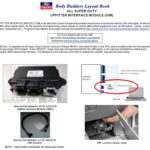It appears you’re encountering a common issue: connecting an ELM327 Bluetooth OBD-II scanner to your iPhone. Many users find that while these scanners work seamlessly with Android devices, iPhones can present pairing challenges. Let’s delve into why this happens and explore potential solutions.
OBD-II (On-Board Diagnostics II) is a standardized system used in most modern vehicles, providing access to a wealth of data from your car’s computer. Devices like the ELM327 Bluetooth dongle plug into your car’s OBD-II port, allowing you to read diagnostic trouble codes, monitor engine performance, and more, typically through a paired device.
The core of the problem often lies within Apple’s Bluetooth protocol and security restrictions. Standard ELM327 Bluetooth adapters typically utilize a Bluetooth Classic connection, which iPhones, especially older models like the iPhone 5, are not configured to pair with in the same way as Android devices for OBD-II purposes. Android devices often handle these generic Bluetooth connections more openly, allowing for straightforward pairing with OBD-II adapters.
When you attempt to pair an ELM327 Bluetooth device through the iPhone’s Bluetooth settings, it may not even appear in the list of available devices. This is different from the experience on an Android device, where the ELM327 is usually readily discoverable and pairable.
So, why does this occur specifically with iOS devices? Apple’s iOS ecosystem prioritizes security and often requires specific protocols or certifications for Bluetooth accessories to connect seamlessly, especially for data transfer. ELM327 Bluetooth adapters, being generic and designed for broad compatibility, often don’t meet these specific Apple requirements for direct pairing through the settings menu for data communication.
However, this doesn’t mean it’s impossible to use OBD-II scanners with your iPhone 5 or other iOS devices. There are a few key workarounds and solutions:
-
Wi-Fi OBD-II Scanners: Instead of Bluetooth, consider using an OBD-II scanner that connects via Wi-Fi. These devices create their own Wi-Fi network, which your iPhone can join, bypassing the Bluetooth pairing limitations. Wi-Fi OBD-II scanners are often more compatible with iOS devices.
-
Bluetooth Low Energy (BLE) OBD-II Scanners: Some newer OBD-II scanners utilize Bluetooth Low Energy (BLE), which is a different Bluetooth protocol. BLE is often more compatible with iOS devices. Look for OBD-II scanners specifically advertised as “Bluetooth 4.0” or “BLE” compatible with iOS.
-
App-Specific Pairing: Many OBD-II apps designed for iPhone are engineered to handle the Bluetooth connection internally. Instead of pairing through the iPhone’s Bluetooth settings, you might need to connect directly through the OBD-II app itself. Check the instructions of your chosen OBD-II app for specific pairing guidance. Some apps may require a Wi-Fi or BLE scanner even if they mention “Bluetooth” in their features due to iOS limitations.
-
Check Compatibility Lists: Before purchasing an OBD-II Bluetooth scanner for your iPhone 5, always check compatibility lists provided by the scanner manufacturer or OBD-II app developer. These lists will often indicate which scanners are known to work with iOS and specific iPhone models.
In conclusion, while direct Bluetooth pairing of standard ELM327 adapters with iPhones can be problematic due to iOS Bluetooth handling, it’s not a complete roadblock. By understanding the limitations and exploring Wi-Fi or BLE based scanners, or app-specific pairing methods, you can still effectively use OBD-II diagnostics with your iPhone 5 and gain valuable insights into your vehicle’s performance. Always prioritize checking compatibility before purchasing to ensure a smooth connection.

